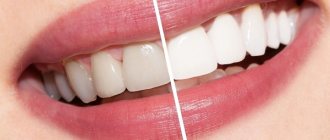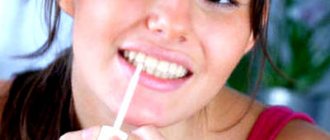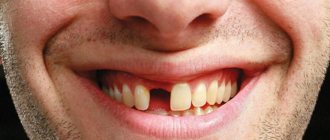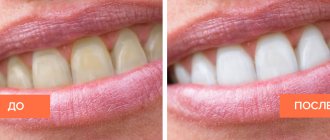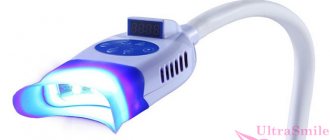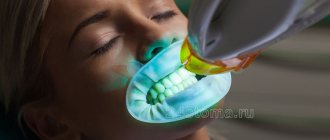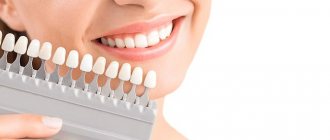A beautiful smile is the key to success!
The main wealth of a person at all times is his health.
And recently it has also become a criterion of well-being and wealth. Every day more and more people focus their attention on the condition of their teeth and the beauty of their smile, because this is a requirement of the time and one of the components of the image of a prosperous person. Thanks to the tireless work of dentists throughout our country and constantly flashing commercials on television, the value of healthy teeth, fortunately, has become clear to our people. Having left the panic fear of the dentist's office in the distant past, we are paying more and more attention to our teeth. Requirements have increased both for the quality of the treatment and the absence of pain, as well as for improving the aesthetic component of the result: the shape, color and naturalness of the teeth. Many patients complain about the dark color of their teeth, pigments and stains on the enamel that cannot be removed with toothpaste and a brush. It is not advisable to cover teeth with crowns or composite and ceramic veneers - veneers, since this requires removing a layer of enamel, that is, grinding the tooth. To solve the problem of teeth whitening, there are various techniques that we would like to introduce you to. the mechanical cleaning
method , which includes professional oral hygiene, and
the chemical whitening method
, which is based on the occurrence of oxidative processes that arise as a result of the action of atomic oxygen on the natural tissues of the teeth.
Results and discussion
We present a specific clinical situation. Patient V., 20 years old, came for teeth whitening. A preliminary examination of the oral cavity was performed, professional hygiene and training in individual dental care were performed. After the conversation, including the expected results of whitening, the patient signed an informed consent.
The effectiveness of whitening was assessed by comparing the tooth color with the standard VITA 3D-MASTER shade chart. The initial shade was determined by the doctor with the participation of an assistant and the patient himself, and was recorded in the medical history. In this case, it is D3 (No. 10). Subsequent registration of indicators was carried out on the 3rd, 5th and 7th day and long-term periods (Fig. 2).
Rice. 2. Procedure for determining tooth shades.
After determining the color of the teeth, we turned on the BEYOND® Polus® Advanced accelerator and programmed the time for the complex teeth whitening procedure on both jaws in the Medium/Normal mode. The patient, sitting in a chair, was asked to put on safety glasses (Fig. 3).
Rice. 3. The patient is prepared for whitening.
The teeth were mechanically cleaned with a special brush and polishing paste. The patient was asked to rinse his mouth (Fig. 4).
Rice. 4. Beyond system retractor.
A protective cream was applied to the lips and the BEYOND® Polus® retractor was placed in the mouth, pointing the retractor tongue down.
The teeth and gum mucosa were dried using compressed air. With the syringe positioned at an angle of 45° to the surface of the teeth, a protective layer of BEYOND® BlueSeal® Gingival Protection with a thickness of 2-3 mm was applied along the gingival margin, sequentially from one quadrant to another (Fig. 5, 6). The same material was used to cover the hypersensitive cutting edge of the lower teeth.
Rice. 5a. The protective layer (a) is applied to the area of the second quadrant (b).
Rice. 5 B. The protective layer (a) is applied to the area of the second quadrant (b).
Rice. 6. The central area of the upper dentition is covered with a protective layer.
Having removed the LED Curing Light from the back panel of the device, it was placed at a distance of 0.5-1 cm from the gingival surface. To begin curing, press button C on the body of the curing lamp. The device was moved in a circular motion along the gingival area, exposing the protective layer for 20-30 seconds: approximately 2-3 seconds per tooth (Fig. 7). A dental probe was used to check the quality of curing of the protective layer.
Rice. 7. Light curing of liquid rubber dam.
The two-barrel bleaching gel syringe and mixing tip were removed from the vacuum packaging (Figure 8).
Rice. 8. Whitening gel and accessories for it.
Place the tip on the syringe. By pressing the piston, BEYOND™ II Advanced Formula hitening Gel was squeezed onto the dry surface of the teeth in a layer 2-3 mm thick (Fig. 9).
Rice. 9. Applying whitening gel to the surface of the teeth.
The shade of the Beyond lamp was placed at a 90° angle to the teeth, as close to their surface as possible.
Once the lighting fixture was installed in the desired position, press the START/PAUSE button and begin the first cycle (Fig. 10, 11, 12).
Rice. 10. General view of the whitening procedure.
Rice. 11. Exposure of the bleaching area to light.
Rice. 12. Light activation of the gel.
The patient was informed about the safety of swallowing saliva during the procedure and was given a remote control, which can be used if necessary to pause the procedure or call a doctor.
Music was played for the patient during the exposure.
After the light was automatically turned off, the whitening gel was removed using a saliva ejector. Then the procedure was repeated. A total of three cycles were performed. Each was repeated for 10 minutes.
After the final procedure, the whitening gel was completely removed with a saliva ejector (Fig. 13). The gingival protective film, cotton rollers, protective napkin, and retractor were also removed. The patient took off his safety glasses and rinsed his mouth with water.
Rice. 13. View of the dentition immediately after turning off the Beyond lamp.
He was shown a new shade of tooth enamel (Fig. 14). They suggested using the Post-Whitening Teeth Care Guide and a sample of BEYOND® Pearl White® Advanced Formula Whitening Toothpaste.
Rice. 14. Determination of enamel shade after the procedure.
The patient was reminded that for 24 hours after the procedure he should avoid consuming food and drinks containing coloring substances. Smoking should also be limited or eliminated. It has been reported that, depending on diet, oral hygiene and smoking intensity, periodic corrective procedures may be necessary to maintain whitening results.
A post-procedure oral examination did not reveal any side effects. The mucous membrane of the gums was the usual pale pink hue. The teeth had color B2 (No. 3), i.e. the result was 7 conditional points (subtract No. 3 from the original No. 10). The patient was satisfied with the whitening effect. After a week, the shade of the enamel did not change upon visual assessment. The patient complied with the recommendations given to him. During 6 months of observation, color fastness was maintained.
Professional oral hygiene
Everyone has probably heard about teeth whitening using Air-Flow in one day.
Advertising is advertising. Using the AirFlow air-abrasive handy blaster system, produced by the Swiss company EMS, or similar systems from other manufacturers, such as Profy Mate (NSK), Profy Jet (Densply), etc. Mechanical cleaning of pigmented plaque (especially smoker’s plaque) and polishing of the tooth surface are carried out in combination with the removal of dental plaque. This event is mandatory when carrying out sanitation of the oral cavity, prevention and treatment of periodontal diseases (support-retaining apparatus of the tooth). In the photographs we see teeth cleaned of plaque and polished, which have been restored to their natural color using mechanical cleaning; however, it is impossible to change the color of the enamel, making it several shades lighter, which, in fact, is what teeth whitening is, is impossible with this method. AirFlow or systems similar in their method of action are used in preparation for whitening - they are used to remove dental deposits, stones and hard plaque, otherwise the “bleach” simply will not penetrate through them.
What whitening methods are there?
The dentist will advise which teeth whitening is safe for each patient individually. But everything that takes place under the supervision of a doctor will definitely not harm - there is no doubt about it, especially when using the latest technologies, delicate compounds and modern developments.
Professional teeth whitening methods:
- Photobleaching;
- laser whitening;
- whitening gel only;
- hardware method.
The first two methods use a lamp or laser as a catalyst for the action of the whitening gel.
Photobleaching, for example, ZOOM, enhances the effect of active hydrogen peroxide, helping to quickly break it down into free radicals - oxygen atoms. of up to 10 tones occurs.
. With proper care, the results last for several years.
The laser procedure differs in that instead of a light beam, a laser beam acts. It can heat the surface, which causes sensitivity (everything is in the hands of a professional doctor, since the advantage of a laser is accuracy), and copes well with changing color by 10-12 tones
and maintaining it for up to 5 years. The downside is the high cost of the method.
Dentists are still arguing about what is the safest teeth whitening, and whether laser and light are necessary for the best results. But it has been proven that the method of applying gel without using them is also effective. Opalescence technology with 40% hydrogen peroxide in the gel is cheaper in price and has proven itself in aesthetic dentistry.
A simple dental cleaning at the clinic is often sufficient for many people. After removing stones and plaque, the teeth become several shades lighter. Using one of these methods:
- Air-Flow hardware cleaning (the principle is similar to a sandblasting machine, but instead of sand, soda);
- ultrasound.
You can be satisfied with the result of your renewed smile.
What is whitening?
We will talk about bleaching - a chemical oxidation process, as a result of which, under the influence of oxygen, organic substances are broken down into carbon dioxide and water. During oxidation, organic substances are oxidized to intermediate products that are lighter than the original ones. During this reaction, the oxidizing agent (substance H2O2 - hydrogen peroxide), which has a free radical with a non-polar electron, gives it to the oxidized substance. The substance being bleached accepts a non-polar electron and is thus oxidized. The low or high percentage of strong free radicals depends on the acidic or alkaline environment in which the ionization process occurs. Back in the middle of the second half of the 19th century, articles were published about teeth whitening under the influence of hydrogen peroxide. Currently, modern bleaching systems use carbamide peroxide, chlorides, urea peroxide and hydrogen peroxide, one of the decomposition products of which is atomic oxygen. The intensity of tooth color is determined by the number of paired C=C compounds. Oxidation leads to the formation of a simpler, single carbon compound, which reduces pigmentation, i.e. teeth whitening. Whitening does not affect the surface of fillings and artificial crowns, so after it is completed, color differences may appear, to eliminate which replacement of the fillings or crowns covering the teeth is indicated.
Materials and methods
To whiten the crowns, we used Beyond transparent gel, based on 35% hydrogen peroxide, the process of mixing the components of which takes place in a mixing attachment.
To lighten tetracycline teeth and deep pigmentation, a kit was used that additionally included sodium perborate and hydrogen peroxide, which were mixed before the procedure and applied to the teeth for 5-6 minutes, after which standard whitening was carried out.
Activation of the reaction was carried out with a cold light lamp (LED) - BEYOND - in a mode corresponding to the clinical picture.
Low/gentle - low/soft: the light intensity emitted at this setting is 210,000 LX and is recommended for patients with high tooth sensitivity, fluorosis, hypoplasia or visible enamel defects (small cracks or chips). The procedure time with this setting has to be increased, given the weak level of emitted light.
Medium/normal: Light intensity is 250,000 LX and is recommended for patients with healthy enamel yellowing caused by the consumption of staining foods, drinks and tobacco products. This regimen can also be used for patients with moderate fluorosis, as well as in cases of moderate tetracycline staining.
High/intense: The light intensity emitted at this setting is 300,000 LX and is recommended for patients with tetracycline staining and gray age-related discolourations.
To preserve the results of in-office whitening, the patient was offered an innovative home whitening system - e-Bright, in which, to enhance the effect, the gel is activated by rows of LEDs built into the accompanying tray.
To evaluate the effectiveness of treatment, the following method was used:
The ordinal numbering of shades of the 16-color scale can be presented as follows:
| (1) | (2) | (3) | (4) | (5) | (6) | (7) | (8) | (9) | (10) | (11) | (12) | (13) | (14) | (15) | (16) |
| B1 | A1 | B2 | D2 | A2 | C1 | C2 | D4 | A3 | D3 | B3 | A3.5 | B4 | C3 | A4 | C4 |
It allows you to quantify the effectiveness of bleaching. For example, with color B3 (ordinal number on the color scale 11), at the beginning of treatment after exposure, the tooth acquired shade D2 (ordinal number 4), whitening can be expressed quantitatively as 7 ranks (points): 11 minus 4.
Before the procedure, the color shade of the teeth was recorded using a digital camera.
Why do teeth change color?
The color of teeth is polychromatic, it changes in the areas of the neck, cutting edge and area of contact with the gum, depending on the thickness, degree of reflection of various shades and translucency of the enamel and dentin (inner part of the tooth).
In addition, changes in the color of enamel are affected by: - the predominance in food of products that have a strong coloring effect: coffee, strong tea, Coca/Pepsi-Cola, blueberries, blackberries, red wine, soy sauce (staining the tooth from light brown to black) ; - smoking tobacco. Nicotine and a high content of various tars (even in the lightest cigarettes) cause the enamel to stain from yellow-brown to black; — medicinal effects of drugs during the period of tooth formation. (antibiotics, especially tetracycline); — chemical influence (increased fluoride content in drinking water leads to a disease called fluorosis);
— genetic predisposition (hereditary factor and systemic diseases suffered at an early age); — incorrect dental intervention and complications; - age-related changes in tooth color. All of the above reasons that cause discoloration of teeth are indications for whitening.
“Making beauty” at home
Home whitening methods use individual dental trays for whitening gel, the concentration of which varies between 9-22%. Despite the fact that the home method is relatively slow and is carried out over 2-6 weeks (depending on the severity of the condition and some features of the structure of the tooth enamel, for example, with a disease such as fluorosis), the result is almost always wonderful. There is rarely any change in tooth sensitivity, which is quickly restored after the procedures are completed. Teeth, while lightening, retain the natural coloring of the entire surface and do not change their natural appearance. The desired effect is not always achieved only in teeth with tetracycline pigmentation and other types of color changes in the deep tissues of the teeth.
Professional approach
Our clinic prefers the OPALESCENCE whitening system manufactured by Ultradent. We also use in practice and offer patients Rembrandt oral hygiene products. Opalescence, Rembrandt and Colgate are among the few whitening systems that are recognized and trademarked by the American Dental Association (ADA). The Opalescence teeth whitening system is registered by the Ministry of Health of the Russian Federation. Opalescence gel contains 20% water, which helps to avoid hypersensitivity or reduce it, without drying out or dehydrating the enamel. The active ingredient in the Opalescence system is carbamide peroxide. Whitening pastes contain various flavoring additives - neutral, banana, menthol and watermelon flavors. Various concentrations of urea peroxide are available (Opalescence 10%, 15%, 20%) with and without fluorine. 35% Opalescence X-tra with carotene is intended for whitening only in the doctor's chair. The procedure for using the home version of Opalescence is not complicated, but requires strict adherence to the instructions. On the first visit, the dentist determines the initial color of the teeth, studies the medical history, removes dental plaque, and takes impressions of the dentition for subsequent production in the laboratory of individual aligner reservoirs in which the whitening gel will be placed. On the second visit, the mouth guards are tried on, they are adjusted, the patient is taught the technique of applying the gel, the procedure for use, the daily or night protocol for use is explained, and a particular toothpaste is recommended. On the third visit, the achieved result is assessed. The whitening effect is comfortable for the patient and others when the shade of the teeth is lightened by 2-4 tones. Attention!
Filling materials are not bleached. Old fillings need to be replaced, since the whitened teeth will be much lighter, but this should be done no earlier than after 14-15 days. During this time, all cabamide peroxide leaves the tooth tissue, and the shade of the enamel stabilizes. Then you can proceed to the restoration of teeth and select the shade of the composite material that matches the shade of the bleached enamel.
Why can't you whiten your teeth?
Contraindications to teeth whitening are: - the presence of an allergic reaction to hydrogen peroxide or other components of the drug used for whitening; - lightening of superficial pigment spots, which can be easily removed with professional teeth cleaning and proper oral hygiene; — a large number of carious areas, defective fillings, periodontal diseases in the active stage, abundant dental plaque (in this case, you must first undergo oral sanitation); - pregnancy or breastfeeding; - excessively enlarged pulp chamber. Not recommended for children and teenagers.
Teeth whitening: harmful or not?
To answer with confidence whether teeth whitening is harmful, it is worth considering that there are different methods. Some try to get a snow-white smile at home using the folk method - baking soda, wood ash and activated carbon. The combination of these components is characterized by a high degree of abrasiveness. They remove not only plaque from the surface of the teeth, but also dental tissue. How harmful teeth whitening is in this way is obvious. Frequent implementation of the procedure will lead to severe thinning of the enamel, increasing its sensitivity to influences from the external environment. Other disadvantages include the appearance of microcracks, which can serve as a place for the proliferation of pathogenic microorganisms and the development of the carious process.
Another way to lighten enamel is to use special pastes. But it is not recommended to choose them yourself; a dentist should select them. He will conduct an examination, assess the condition of the teeth and only after that will recommend a suitable toothpaste. The products are useful because, thanks to the presence of fluoride compounds and antibacterial components in the composition, it is possible to both remove plaque from the surface of the teeth and prevent carious lesions. It is important to consider that it is not recommended to use such pastes constantly, only in a course. This is due to the fact that prolonged use of pastes with a high abrasiveness will negatively affect the surface layers of the tooth and lead to increased sensitivity.
Professional teeth whitening “Zoom” occurs due to active oxygen, which discolors dentin pigments. This Method is very gentle, oxygen does not change the structure of the enamel and does not damage the teeth. To prevent the procedure from causing harm, it should not be performed if there are contraindications. These include:
- enamel erosion;
- carious lesions of teeth;
- pregnancy (in any trimester);
- children's age (up to 18 years).
Among the relative contraindications, the presence of large fillings on the front teeth is noted. If the patient’s enamel is too sensitive, the teeth must first be prepared for the procedure by saturating them with calcium and fluoride compounds.
Another popular type is laser whitening. With its help, in one session, you can achieve a tooth color that is 6-10 shades lighter than the original. The high efficiency is explained by the peculiarity of the installation: the laser has a directed beam flow. The procedure is completely safe. The intensity and period of radiation exposure are selected individually for each patient. There is no thermal damage to the enamel and gums, and there is no risk of increased tooth sensitivity.
A beautiful smile is the key to success!
Smile with us! The dentists at our Center will help you make your smile sparkling for a long time. The department is equipped with the latest technology and has everything necessary to perform high-quality work: a modern dental complex, high-quality X-ray equipment and the latest generation materials. Each patient is guaranteed high-quality treatment and an individual approach to teeth whitening. If, after whitening, you need to replace old fillings with defects with new ones or cure caries, all these problems can also be solved in our dental department.
Remember that beautiful teeth are your calling card in our modern world!
